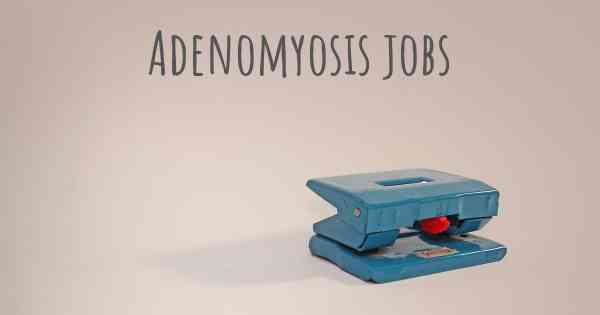Can people with Adenomyosis work? What kind of work can they perform?
See how people with experience in Adenomyosis give their opinion about whether people with Adenomyosis can work and what kind of jobs are more appropriated for people with Adenomyosis

Can people with Adenomyosis work?
Adenomyosis is a medical condition that affects the uterus, causing the tissue that normally lines the uterus to grow into the muscular walls of the organ. This can result in a range of symptoms, including heavy or prolonged menstrual bleeding, severe pelvic pain, and discomfort during intercourse. While Adenomyosis can be debilitating for some individuals, it does not necessarily mean that they are unable to work.
Whether or not a person with Adenomyosis can work depends on the severity of their symptoms and how well they are managed. It is important to note that Adenomyosis affects each person differently, and the impact on their ability to work can vary significantly.
Managing Adenomyosis symptoms
Adenomyosis symptoms can be managed through a combination of medical treatments and lifestyle changes. The goal of treatment is to alleviate pain, reduce heavy bleeding, and improve overall quality of life. Some common treatment options include:
- Medications: Nonsteroidal anti-inflammatory drugs (NSAIDs) can help relieve pain and reduce inflammation. Hormonal medications, such as birth control pills or intrauterine devices (IUDs), may also be prescribed to regulate menstrual cycles and reduce symptoms.
- Surgical interventions: In severe cases, surgery may be recommended. Procedures such as endometrial ablation or hysterectomy can provide long-term relief from symptoms, but they are typically considered as a last resort.
- Lifestyle changes: Adopting a healthy lifestyle can also help manage Adenomyosis symptoms. This includes regular exercise, stress reduction techniques, and a balanced diet.
Impact on work
The impact of Adenomyosis on a person's ability to work can vary depending on the severity of their symptoms and the nature of their job. Some individuals with mild to moderate symptoms may be able to continue working without significant disruption, while others with more severe symptoms may require adjustments or accommodations.
It is important for individuals with Adenomyosis to communicate with their employers about their condition and any limitations they may have. This can help facilitate a supportive work environment and ensure that necessary accommodations are made. Some potential adjustments that can be considered include:
- Flexible work hours: Allowing flexibility in work hours can be beneficial for individuals with Adenomyosis, as they may experience fluctuations in symptoms throughout their menstrual cycle.
- Remote work options: Depending on the nature of the job, working remotely can provide individuals with Adenomyosis the flexibility to manage their symptoms from the comfort of their own home.
- Modified duties: In some cases, modifying certain job tasks or responsibilities can help individuals with Adenomyosis continue working while minimizing discomfort.
- Accommodations for pain management: Providing a quiet and comfortable space for individuals to manage their pain, such as a designated rest area, can be beneficial.
It is important to note that the Americans with Disabilities Act (ADA) in the United States and similar legislation in other countries protect individuals with disabilities, including those with chronic health conditions like Adenomyosis. These laws require employers to provide reasonable accommodations to enable individuals to perform their job duties.
Support and self-care
Living with Adenomyosis can be challenging, both physically and emotionally. It is crucial for individuals with this condition to prioritize self-care and seek support when needed. This can include:
- Building a support network: Connecting with others who have Adenomyosis or joining support groups can provide a sense of understanding and validation.
- Seeking medical guidance: Regularly consulting with healthcare professionals who specialize in Adenomyosis can help individuals manage their symptoms effectively.
- Practicing self-care: Engaging in activities that promote relaxation and well-being, such as meditation, yoga, or hobbies, can help reduce stress and improve overall quality of life.
Conclusion
While Adenomyosis can present challenges, it does not necessarily mean that individuals with this condition cannot work. The ability to work depends on the severity of symptoms and how well they are managed. With appropriate medical treatment, lifestyle adjustments, and workplace accommodations, many individuals with Adenomyosis are able to continue working and lead fulfilling professional lives.
Posted Mar 20, 2017 by Kate 1000
Posted Sep 10, 2017 by Marissa 2010








